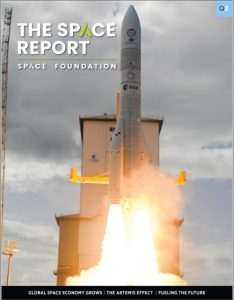The US-based nonprofit organisation says – in its Space Report Q2 – that the growth is consistent with the industry’s five-year compound annual growth rate of 7.3%, with the space economy doubling in size from a decade ago.
Other highlights of the report include commercial revenues topping $445 billion, representing 78% of the space economy, which is 5.5% higher than 2022.
“Our annual global space economy analysis highlights the increasing importance of the space industry across both public and private sectors,” said Heather Pringle, CEO of Space Foundation.
“Established subsectors and emerging markets cover an expanding range of space applications in our daily lives and push the boundary of what’s possible on and off Earth.”
Global space economy
In terms of leading subsectors, Positioning, Navigation and Timing remained the largest commercial subsector with $209 billion in revenues, ($11 billion more than 2022). The the largest category was Ground Stations and Equipment, which grew to $17 billion, followed by commercial satellite manufacturing and launch revenues.
International government spending on space programs grew 11% in 2023 to $125 billion, which represents – amid increasing geo-political uncertainty – double-digit growth for a third year.
Military spending
For specifically military spending, global space budgets grew 18% to $57 billion, representing 46% of total government space spending. The majority of defence spending – 80% of it – comes from the United States.
Other points to note were that nine of the top-spending governments increased their budgets by double-digits last year: the United States, China, Japan, Russia, the European Union, France, Germany, Italy, and South Korea.
The Space Foundation’s full analysis will be published in The Space Report Q2 edition on July 30.
See also: Satellite broadband boosts global space economy reports Space Foundation

